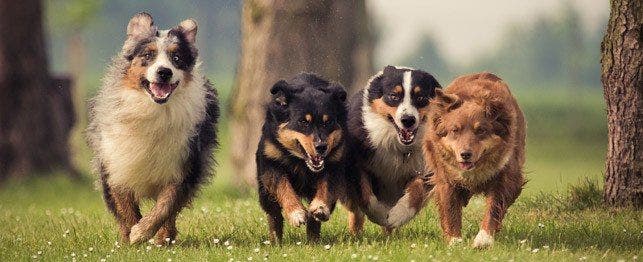
8 Simple Rules of Dog Park Etiquette
Dog parks offer a way for owners to give their dogs the social interaction with other dogs that they crave (and need), while providing a fun place to get some great off-leash exercise.
But, dogs don’t always get along, and owners don’t always observe basic etiquette and safety guidelines.
Don’t assume that your dog is ready to mix and mingle at a dog park. First, can he handle being around other dogs? Second, do you know how to keep him from biting or being bitten by another dog?
To ensure you and your dog enjoy your next outing safely, here are eight simple rules of dog park etiquette.
1. Recognize the Danger Signs
Before letting your dog off the leash at a dog park, be sure you know how to distinguish friendly dog behavior from threatening behavior. When you notice play is escalating into aggression, you need to be ready to take your dog out of the situation.
2. Leave the Treats and Toys at Home
Dogs can become aggressive when they see something they want, or if another dog is trying to take their toy or treat. Only take these items if you are sure your dog will be far away from other dogs. Some parks ban toys and treats because they always pose a risk when they are present, so make sure you know the rules of the park you are visiting and be extra careful.
3. Blow Off Some Steam First
It may seem like a good idea to take your dog to the park after he’s been cooped up all day, but this may be asking for trouble. Many dog owners view the park as the place for exercise. It’s understandable to think this way, but don’t make this mistake. Take your dog for a walk or play in the yard for a few minutes before heading to the park.
Dogs who have not had recent exercise will arrive at the park with too much excess energy, which often results in aggressive behavior toward other dogs and humans. An overly-aggressive dog, although he may be “only playing,” can cause fights or be viewed as prey by larger dogs if he is running around with too much frantic energy.
4. Scope Out the Situation
When going to a park for the first time, it’s best to leave your dog in the car for a brief moment and assess the park before going inside. If you’re not driving, find a place to tether your dog for a few moments. If there are dogs behaving badly or small children that may bother your pup, you may reconsider taking your dog to that park.
5. Don’t Bully or Be Bullied
Pay close attention to your dog’s behavior and how other dogs are treating him. If another dog is being too rough, ask his owner to control him, then get your dog out of harm’s way. Make sure you are able to recognize when your own dog is being overly-aggressive, and be ready to take him away from other dogs.
If your dog lacks manners when meeting people and other animals, you might not want to take him to the dog park. If he has a tendency to charge up to, mount, or incessantly sniff other dogs, keep him away from the crowds.
6. Lose the Hazardous Training Devices
Choke chains, harnesses, and prong collars should not be left on your dog when he’s playing in the park. Dogs nibble when they play, and the metal equipment can cause broken teeth or other injuries. Also, if a dog gets stuck in a harness, it can lead to a fight. Safe alternatives are breakaway nylon or leather collars.
7. Don’t Bring Females in Heat, Unvaccinated Dogs, or Very Young Puppies
Make sure you recognize when your female dog is in heat, and don’t bring her to the dog park. This most often leads to fights among male dogs or aggression toward the female. Also, make sure your dogs are vaccinated so they don’t catch anything from other dogs. Puppies that are less than 12 weeks old should not go to dog parks either, because their immune systems are not strong enough to handle some of the germs circulating in the dog population.
8. Be Careful With Small Dogs
A dog park can be a dangerous place for smaller dogs. Larger dogs sometimes see smaller ones as prey, especially if the little one is running around in a frantic prey-like manner. If a large dog is harassing your small one, don’t pick him up. This actually triggers a predator instinct in the large dog, and is likely to escalate the problem.